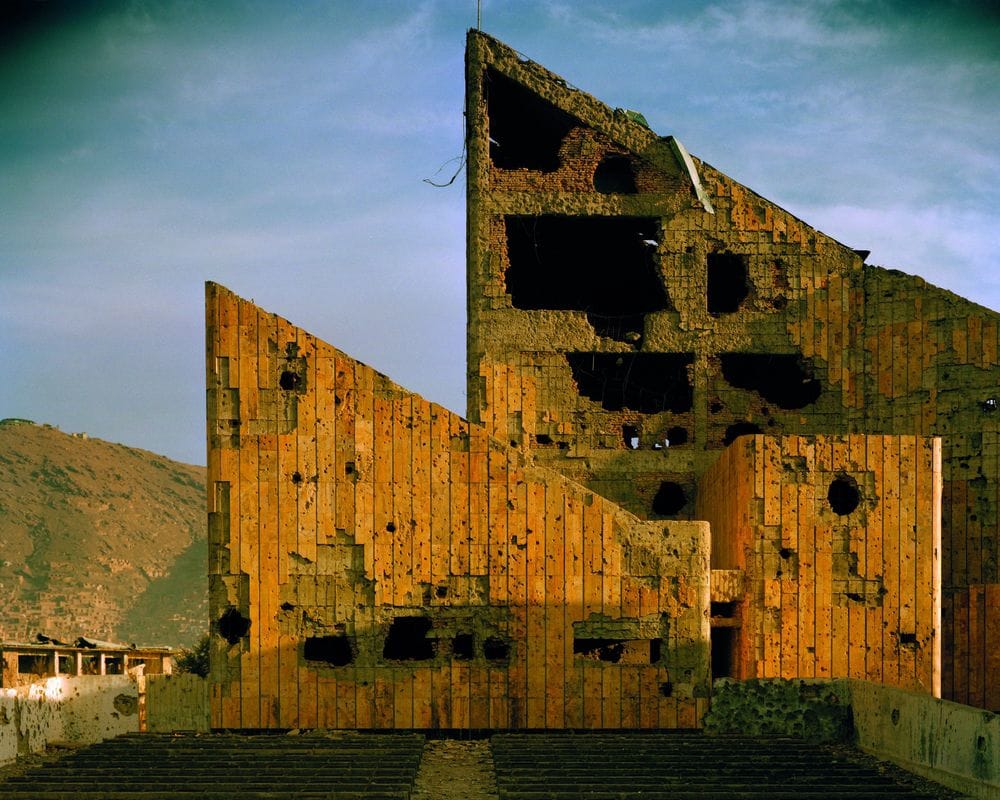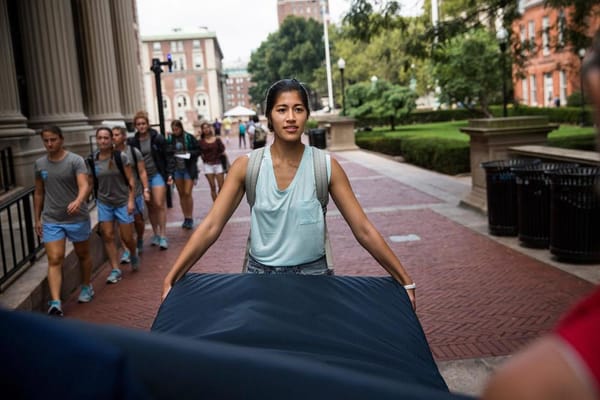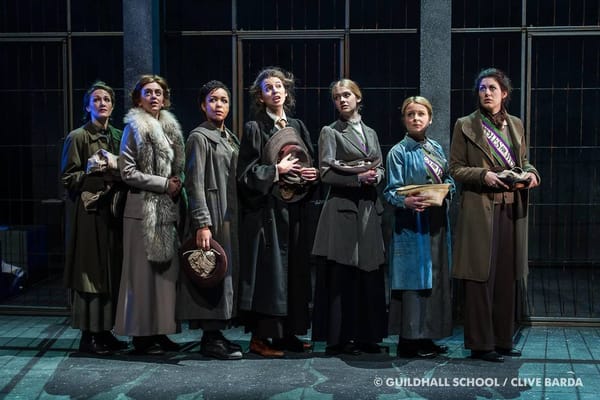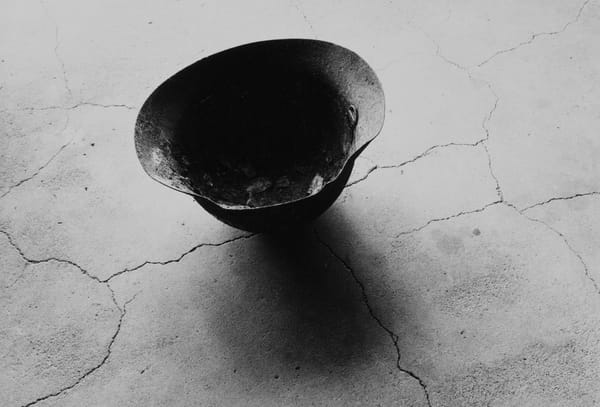The Most Modern Machines for Living
Fred Fyles checks out the Constructing Worlds at the Barbican Centre

The relationship between the architect and the camera is symbiotic: as a uniquely modern medium, photography is perfectly suited to capturing the environments in which we live.
From shanty towns in Soweto to the towering skyscrapers of Manhattan, photographers have long been obsessed with the built world that surrounds us. The Barbican's_Constructing Worlds _draws on the seemingly endless supply of architectural photographers, as well as the discerning tastes of curators Alona Pardo and Elias Redstone, providing us with a wide-ranging overview of this fruitful history.
We begin with Berenice Abbott, whose five year project, Changing New York, documents the rapid expansion of the city during the 1930s. These sumptuous black and white images contain the germ of modern city photography, and alone stand as testament to Abbott’s genius. In these stark, angular constructions girders and pipes burst out of the Manhattan bedrock, twisting up like vines to form a modern metropolis. Although a contemporary and friend of Abbott, Walker Evans’ photos could not be more different in tone. Hired by the Farm Security Administration to research rural America, Evans documented the debilitating effects of the Great Depression on sharecroppers. Using a mix of portraiture and architecture, the links between buildings and their inhabitants are subtly revealed: between vernacular churches and decaying plantation houses overrun with black mould, Evans creates a heady combination of rot and ruin that matches any Southern gothic written by Tennessee Williams.
"The links between buildings and their inhabitants are subtly revealed"
Evans’ methodical approach mirrors the work of Hilla and Bernd Becher, whose quietly powerful documentation of German water towers reveals the unseen design that surrounds us every day. Meanwhile, Lucien Herve explores a slightly more ostentatious piece of design – Le Corbusier’s master plan of Chandigarh, built as a shining beacon of Indian modernity. Used to help communicate Le Corbusier’s artistic vision, Herve’s work is exhaustive in its volume. Thankfully some of his best pieces have been singled out: explorations of shape, light, and volume, they don’t resemble buildings so much as constructivist compositions.
Julius Shulman continues this theme of documentation with his photographs of the Case Study House Program, in which aggressively modernist houses compete with retrograde mid-century furnishings to paint a picture of American convenience. In Case Study House #22, his most celebrated photo, two women in elegant ball gowns are lounging on tasteful sofas, suspended in a glass cube above a panorama of the downtown LA sprawl.
As the exhibition continues to the lower galleries, we experience the work of architectural practice Office KGDVS, who have transformed the space into a series of interlocking shapes, highlighting the dramatic impact architecture and design can have on the viewer. As the focus moves away from America, and becomes more modern, the work looks less at the built environment and more at social fabric.
Nadav Kander's exploration of urban growth is both awe-inspiring and horrific
Some artists featured are unabashedly conceptual, such as Luisa Lambri, who reduces the vast masterpiece of Frank Lloyd Wright’s Fallingwater into a single shaft of light, completely ignoring the impressiveness of the original structure. Helene Binet has more success with her studies of Daniel Liebskind’s Jewish Museum; but then again, it is near impossible to take a poor photo of a building steeped in such deconstructivist drama.
Luckily, we also have a selection of Hiroshi Sugimoto’s work; by far the best conceptual work in the gallery, Sugimoto reduces famous buildings down to a mere black and white impression, obscured and out of focus, as though viewed through a thick fog. Rather than reducing the impact these building have, this instead highlights the architect’s original intentions when it comes to form and shape.
Ed Ruscha and Stephen Shore provide a much needed hit of wry humour with their work, which explored the unsettling banality of everyday America. In Ruscha’s case, this translates to vast photographs of car parks, taken from helicopter, the repetitive blocks building up a pattern on the ground; a modern day shopping-mall Nazca. Shore’s work centres around small towns in the American South, which could easily all be called Uncanny Valley, and highlight the mundane. Underneath the bright, saturated colours, lies an air of menace, as if Twin Peaks had been relocated to Texas.
Towards the second half of the exhibition, the focus broadens in scope, moving away from America, instead looking towards the new megacities springing up in Asia, Africa, and South America. Guy Tillim’s exploration of modernist urban decay in Southern Africa – named Avenue Patrice Lumumba, after the murdered Congolese politician – is particularly interesting, showing us a view of Africa that is far from typical. Sadly the same cannot be said for Simon Norfolk, whose series Chronotropia and Burke Norfolk portray Afghanistan as largely a land of terror and ruined buildings, a rhetoric spouted on a near daily basis in any national newspaper.
A highlight is the work of Nadav Kander, whose exploration of urban growth and massive construction along the Yangtze River in China is both awe-inspiring and horrific. A mighty river, which once ran turbulently for nearly 4000 miles, is now placid, thanks to the construction of the Three Gorges Dam during the late 1990s; as enormous bridges are erected in the background families sit and picnic on the banks; fishermen haul in their catch, seemingly oblivious to the high levels of pollution and industrial run-off.
The task of curating a retrospective on the link between photographers and architects was always going to be difficult, and Pardo and Redstone have done well to select just 18 artists. While the quality and depth of the work displayed somewhat varies – with a strong North American start gives way to a more scattered international reach – the exhibition is unmissable for anyone with even a scant interest in either medium. What with the Barbican’s architectural beauty (although some would contest this), there is hardly a more perfect place for a study of this most natural of relationships.
Constructing Worlds is on at the Barbican Centre until 11th January










